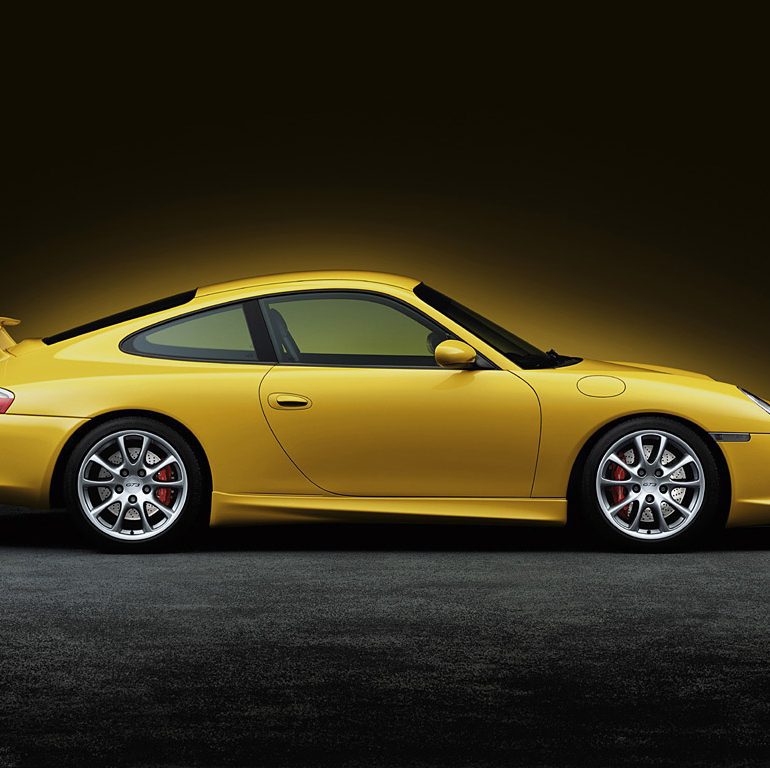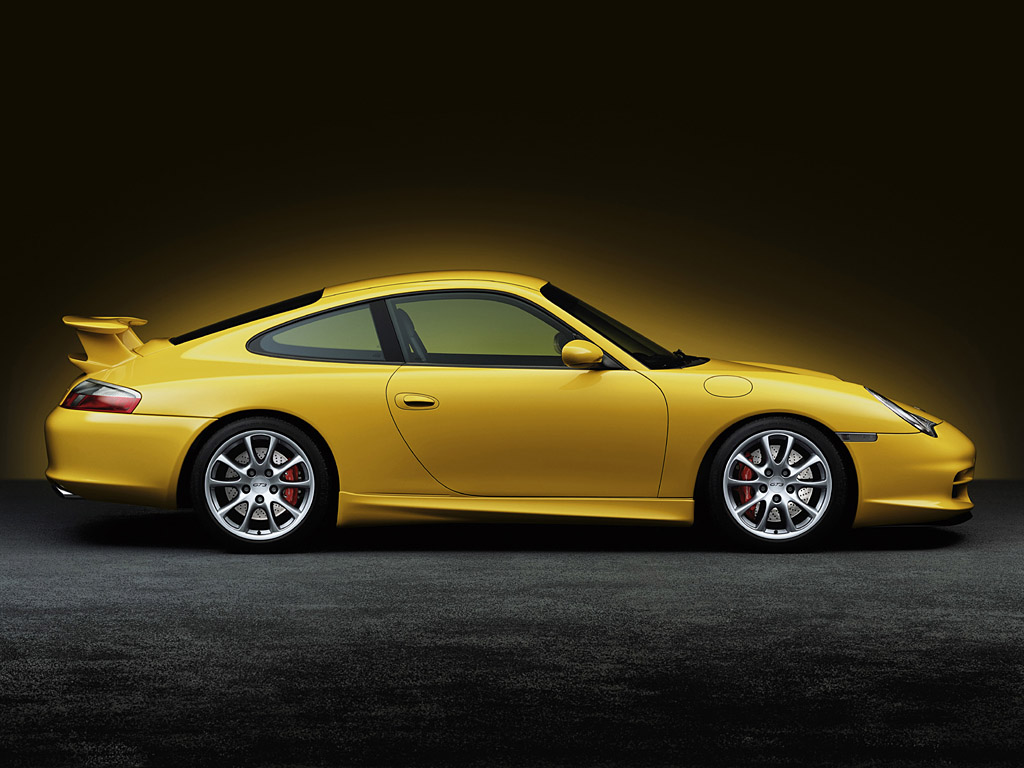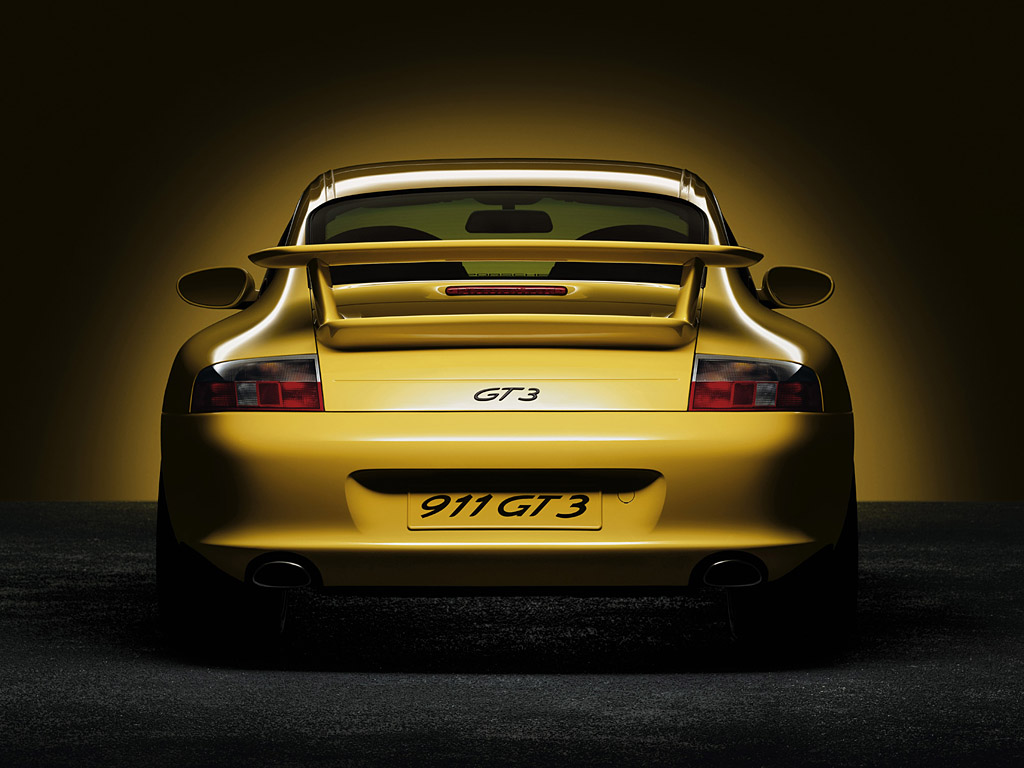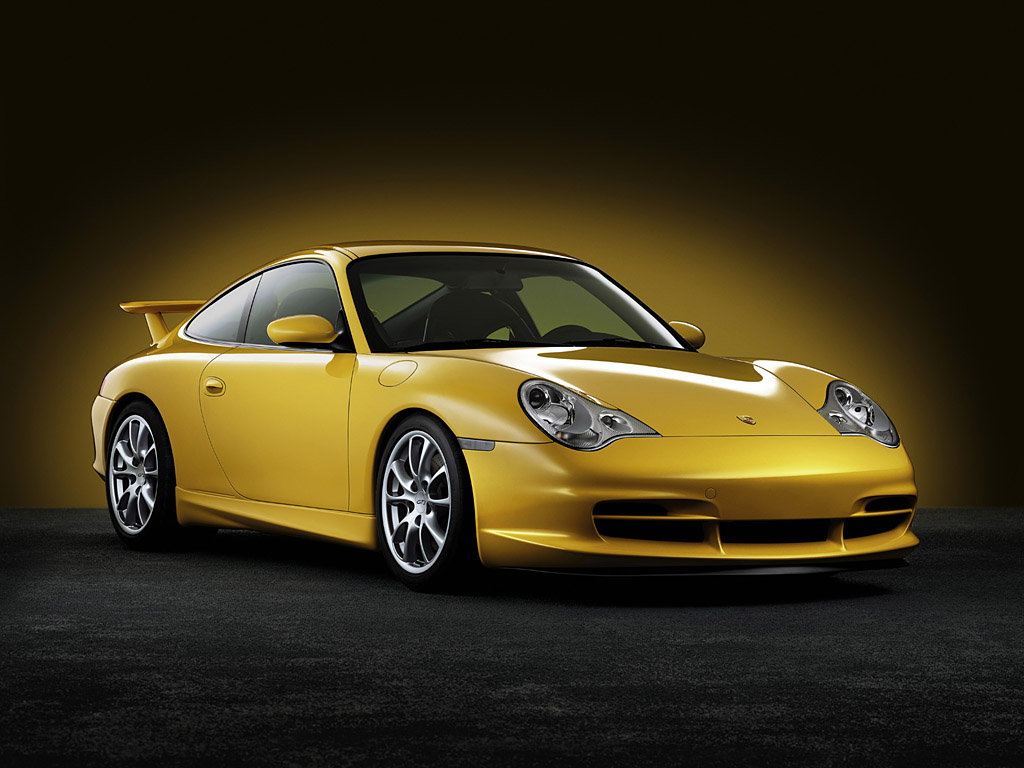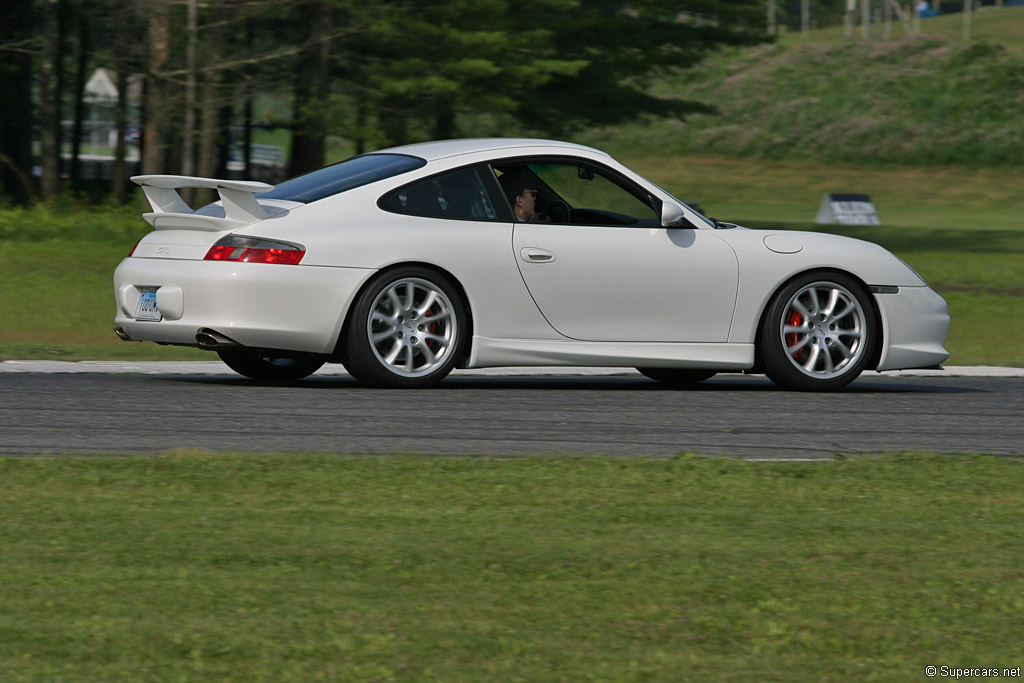2003 Porsche 911 GT3
Porsche has sent its outstanding athlete to the training camp in Weissach, Porsche’s Motorsport Division, and in return has received an even more powerful, sporting and dynamic 911.The new Porsche 911 GT3 comes with all the features of half a century Porsche motorsport. It is a sports car for the purist through and through. A sports car with all the classic virtues a car of this kind is expected to have – and without all the ballast which might in some way impair your outstanding driving experience. It is a sports car allowing lap times on the race track one would never expect of a street-legal road car and, for the first time, is also available in the USA.
The 911 GT3’s power-to-weight ratio clearly confirms that this horizontally-opposed six-cylinder comes in a thoroughbred sports car: 3.6 kilos/bhp in road trim complete with fuel and the driver is truly outstanding. Featuring new, wider but nevertheless lighter wheels, the sports suspension not only offers even better longitudinal and lateral acceleration, but is also able to get the even greater power of the brakes on to the road safely and securely. As an option, stopping power is provided by ceramic brake discs also available from Porsche on the 911 GT3: Porsche Ceramic Composite Brakes or PCCB forshort.
The steel foundation for the bodyshell of the 911 GT3 comes as before from the 911 Carrera 4. To match the enhanced performance of this new sports car, the bodyshell has been further reinforced at all essential points, thus offering an even higher standard of passive safety and enabling the new 911 GT3 to pass all the requisite crash tests with flying colours. At the same time these reinforcements serve to increase static torsional stability by no less than 25 per cent, providing ideal conditions for stable roadholding and exact suspension control.
Enhanced by Porsche’s motorsport specialists to the highest standard, the new 911 GT3 offers a level of driving dynamics only a thoroughbred sports car is able to provide. And this pure driving experience remains untouched by any suspension control systems, with all components being designed and coordinated for the toughest demands when driving on a race track. Indeed, various components on the suspension and the car’s streamlining may be adjusted individually for motorsport requirements.
The Engine- More Power & Performance
Developing 381 bhp (280 kW), the 3.6-litre six-cylinder power unit fitted in the rear offers almost 10 per cent more output. Output per litre of 105.8 bhp (77.8 kW) makes this 3.6-liter flat-six one of the topmost normal-aspiration engines in the world. Benefitting also from streamlining improved to an even higher standard, top speed is now 190 mph (306 km/h).
This further improvement of power and performance is a result of Porsche’s consistent high enginespeed concept based on the reduction of moving masses in the engine. Particularly the pistons and connecting rods as well as the valvetrain benefit from this efficient diet of the engine’s moving masses: Weight of the forged pistons is down thanks to the lower height of the piston jackets by 24 to 404 grams per piston. The piston pins, in turn, are made of a new, high-strength material allowing more slender dimensions with the same strength as before and therefore reducing pin weight from 120 to 96 grams. Overall weight of the six new pistons is 3000 grams, 288 grams or almost 9 per cent less thanbefore.
In support of the new engine’s high speed concept, each moving component in the cylinder charge cycle was weighed once again with utmost precision in search of further weight reduction. As a result, the plates on the steel intake and outlet valves now come with a dome-shaped profile, the valves shedding 19 per cent or, in absolute terms, 252 grams grams of their previous weight.
Another clear pledge to the motorsport orientation of the 911 GT3 is dry sump lubrication with a separate oil tank. Both when applying the brakes to the extreme and remaining on the brakes consistently for a long period, this system ensures an optimum supply of oil to the engine, with a total of five pumps ensuring the necessary lubrication: The main pump in the crankcase feeds oil to the pressure pipes, two suction oil pumps in the crankcase and, respectively, in the cylinder heads feed the oil used back into thereservoir.
6-Speed Gearbox
The new, even more dynamic power unit of the 911 GT3 is matched perfectly by the six-speed gearbox enabling the driver to make optimum use of the engine’s agility particularly at high speeds: At 1.00 and, respectively, 0.85, fifth and sixth gear have a somewhat shorter transmission ratio than the previous gear ratios of 0.97 and, respectively, 0.83. And apart from this change in gear ratios, the synchronising rings on the third, fourth and fifth gear are now made of steel, replacing the former rings made of brass. These new steel rings guarantee the high standard of gearshift precision expected of a sports car, with gear strength and service life increasing approximately by a factor of 10. The driver himself will feel this improvement above all when shifting gears quickly, smoothly and crisply even at high speeds like in motorracing.
Chassis & Suspension
Allowing different settings and adjustments, the chassis and suspension of the 911 GT3 enables the driver to re-align his sports car for specific requirements on the race track.
To reflect the higher standard of performance on the road, the new 911 GT3 comes with even firmer springs, dampers and anti-roll bars. An outside-thread damper leg on the front axle and height-adjustable spring plates provide the possibility not just to lower the height of the vehicle, but also to make the necessary fine adjustments. In the interest of precise damper piston pin mounting with only a minimum influence on axle kinematics under spring load with the springs being compressed, the support bearings come with a single-ball joint resting on a metal and not – as is usually the case with production cars – on rubber. This support bearing is designed to provide two assembly positions for the different camber of road and racing tyres requiring only minor adjustment.
The anti-roll bar on the rear axle is adjustable to four different settings. And the damper leg featuring a single-sleeve gas pressure damper comes with an even firmer response in the compression and rebound mode. At the same time the rear axle has been prepared for the use of racing springs, featuring an outer thread like on the front axle for installation of a height-adjustable spring plate. The springs are cylindrical, arranged concentrically to the steering leg axis, and come with progressive response. The upper spring plate is made of aluminium and is held firmly in place.
New brake System
Indeed, the brakes on the new 911 GT3 are a further development of the system already featured on the previous model. And to take the enhanced standard of performance into account resulting from the increase in engine power and the optimised chassis and suspension, the brake discs on the front axle have been enlarged in diameter by 20 millimetres to 350 millimetres or 13.78 inches.
Measuring 34 millimetres or 1.34 in thickness, the cross-drilled, inner-vented brake discs come with involute cooling ducts patented by Porsche. These sickle-shaped ducts inside the discs act like a turbine, making a significant contribution to the brake disc’s cooling behaviour. The new 911 GT3 comes with far more powerful and efficient six-piston brake callipers finished in red in old Porsche tradition, versus the four-piston fixedcallipers on the former model. These callipers enlarge the contact area between the brake linings and the brake discs by approximately 40 per cent and improve stopping power to an even higher standard even under the toughest conditions.
The only electronic control system fitted in the 911 GT3 is the ABS brake system with intervention parameters matched to the new balance of the chassis and suspension.
911 GT3 Clubsport
The Clubsport version was specially developed to enable the drvier of the 911 GT3 to participate in motorsport with the homologation required but without having to elaborately retrofit his car. Features include a roll cage bolted to the body as well as the absence of side airbags. The cage interacts with the spring strut supports on the rear axle in order to stabilise the car, with chassis and suspension forces being fed not only into the body, but also directly into the roll cage. Under tough motorsport conditions this means that forces acting on the rear spring struts cause only minimum deformation of the body. The rear axle geometry, in turn, is not influenced by these forces and ensures much more precise guidance of the rear wheels serving again to improve the driving characteristics of the 911 GT3 Clubsport.
Instead of leather, the bucket seats in the Clubsport version come in flame-resistant cloth upholstery. And apart from the use of red three-point seat belts the Clubsport model is also fitted with a red six-point seat belt on the driver’s side not homologated for public roads in Germany as well as a fire extinguisher mounted on a separate support.
Story by Dr. Ing. h. c. F. Porsche AG, edited by Supercars.net
In Detail
| type | Series Production Car |
| built at | Germany |
| price $ | $ 99900 |
| engine | Water Cooled, Aluminum, Opposed 6-Cylinder |
| position | Rear Longitudinal |
| aspiration | Natural |
| valvetrain | DOHC, 4 Valves per Cyl w/Varibale Valve Timing, Switching Intake Manifold |
| fuel feed | Multipoint Fuel Injection |
| displacement | 3600 cc / 219.7 in³ |
| bore | 100 mm / 3.94 in |
| stroke | 76.4 mm / 3.01 in |
| power | 284.1 kw / 381 bhp @ 7400 rpm |
| specific output | 105.83 bhp per litre |
| bhp/weight | 262.58 bhp per tonne |
| torque | 385.05 nm / 284 ft lbs @ 5000 rpm |
| redline | 8200 |
| body / frame | Unit Steel |
| driven wheels | RWD |
| front tires | 235/35ZR19 Michelin Pilot Sport Cup |
| rear tires | 305/30ZR19 Michelin Pilot Sport Cup |
| front brakes | Cross Drilled & Inner Vented Discs w/6-Piston Calipers, ABS, Servo Assist |
| rear brakes | Cross Drilled & Inner Vented Discs w/4-Piston Calipers, ABS, Servo Assist |
| front wheels | F 45.7 x 21.6 cm / 18.0 x 8.5 in |
| rear wheels | R 45.7 x 27.9 cm / 18 x 11.0 in |
| steering | Rack & Pinion w/Variable Power Assist |
| f suspension | MacPherson Struts w/Coil over Gas Dampers, Anti-Roll Bar |
| r suspension | Multi-link w/Coil over Gas Dampers, Anti-Roll Bar |
| curb weight | 1451 kg / 3199 lbs |
| wheelbase | 2355 mm / 92.7 in |
| front track | 1486 mm / 58.5 in |
| rear track | 1511 mm / 59.5 in |
| length | 4427 mm / 174.3 in |
| width | 1808 mm / 71.2 in |
| height | 1280 mm / 50.4 in |
| transmission | 6-Speed Manual |
| gear ratios | 3.82:1, 2.26:1, 1.64:1, 1.29:1, 1.06:1, 0.92:1 |
| final drive | 3.44:1 |
| top speed | ~310 kph / 192.6 mph |
| 0 – 60 mph | ~4.0 seconds |
| 0 – 100 mph | ~8.7 seconds |
| 0 – 1/4 mile | ~12.5 seconds |
| drag | 0.29 Cd |


